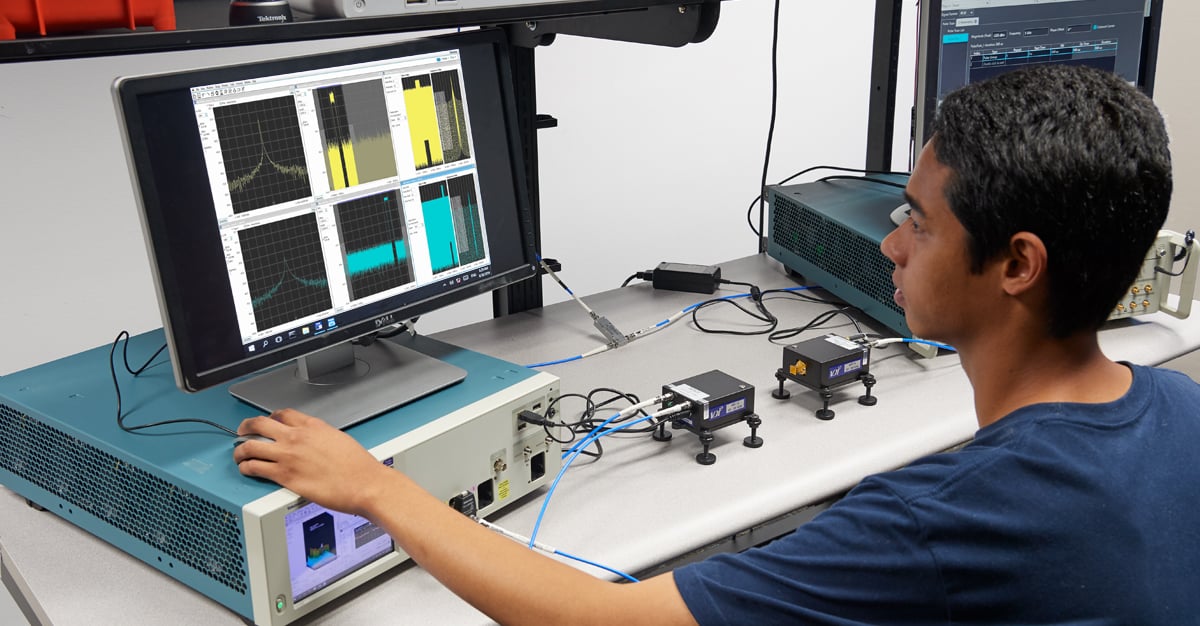

Modern technologies such as MIMO require the need for wide bandwidth, phase coherent, multi-channel analysis. Antenna elements in a MIMO radar system operate independently to cover a wide, often 180-degree, field of view without the need for directivity adjustments. This significantly improves scan times. The MIMO radar employs time, frequency, or coding techniques in each transmit signal to differentiate them in the receiver element to extract target properties.
A wideband oscilloscope, such as a Tektronix DPO70000SX or MSO/DPO70000DX Series oscilloscope, is an ideal instrument because it is designed specifically for wide bandwidths and phase coherency. Paired with SignalVu VSA software version 5.3 for multi-channel controls and analysis, the resulting test system is an excellent choice for validating a MIMO phased array radar because it provides independent settings for parameters such as center frequency, span, and RBW. This is necessary in order to acquire the signals which may have different center frequencies, time slots, or modulation parameters.
Pulse Statistics for Spectrum Analysis
The TDM MIMO radar assigns a time slot for each element. The signal on each channel has a pulse width of one microsecond and PRI of 100 microseconds and slot delay between channel one and channel two is 10 microseconds. With SignalVu software we can see whether the signals generated are aligned correctly to the assigned time slot or not. Using SignalVu’s time overview display to configure the analysis time and spectrum time parameters we can examine the starting position or the start time of the pulses on each channel to determine the time delay between them. Additionally, we can measure the PRI of both channels to determine if this delay is consistently maintained or not. A pulse statistics display allows us to observe the time trend and measurement statistics to see how the PRI varies across pulses over time. The pulse table provides information about the absolute delay between channels or time slot, while the time trend reveals how this delay is maintained over time.
Vector signal analysis using SignalVu VSA Software v.5.3
Frequency vs. Time Using FastFrame™ Segmented Memory
For a comprehensive understanding, we need to analyze over many pulses, yet the scope's record length determines how long a signal can be captured. This turns out not to be a significant limitation thanks to SignalVu's FastFrame mode. Applying FastFrame mode, we capture only the pulse-on time while disregarding the pulse-off time. This innovative method greatly facilitates the analysis of hundreds of pulses without compromising the quality of our analysis. It divides the memory into smaller segments and fills the segments with only the on-time data while preserving the timescale information. For improved signal visualization in FastFrame mode, the Pulse-Ogram displays a waterfall of multiple segmented captures with correlated amplitude vs time and spectrum of each pulse. It can be used with an external trigger to show target range and speed.

FastFrame mode for pulse analysis
Orthogonal Signals Require Independent Controls
The combination of automatic pulse measurements and FastFrame segmented memory capture, along with independent controls, allows us to analyze intricate scenarios such as MIMO radar. With SignalVu software, pulse analysis can be executed concurrently across multiple channels. The advanced pulse analysis package offers up to 31 measurements to automatically characterize the pulse sequences. For MIMO radar, the signals are orthogonal for utilizing distinct center frequencies for each element. Therefore, center frequencies for each channel in SignalVu are configured independently as are span and RBW for each channel. This capability allows us to effectively analyze wide bandwidth, multi-channel phase synchronous systems operating at different frequencies using SignalVu. Having fully configurable and customizable controls in a multi-channel wide bandwidth analysis solution allows you to address even the most complex of scenarios.
Learn more about SignalVu VSA software version 5.3 and Tektronix DPO70000SX or MSO/DPO70000DX Series oscilloscopes online. Embedded digital designers may also have an interest in another blog concerning the FastFrame capabilities built into Tektronix 4 Series B, 5 Series B, and 6 Series B MSO oscilloscopes.



